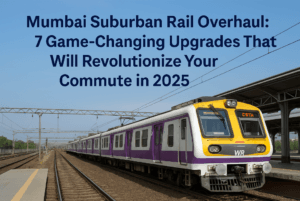Mumbai Suburban Rail Overhaul: 7 Game-Changing Upgrades That Will Revolutionize Your Commute in 2025
The Indian Railways, in collaboration with Maharashtra’s government, unveiled a ₹1.73 lakh crore overhaul for Mumbai’s overburdened suburban network, prioritizing decongestion, safety, and passenger comfort. Key initiatives include 300+ km of new tracks (₹17,000 crore) to boost capacity, 238 advanced AC rakes for heat-resilient travel, and Kavach 5.0, a cutting-edge signaling system slashing train gaps to under 2 minutes for 40% more peak-hour services.
The Mumbai One Card will unify payments across trains, metros, and buses, streamlining transit for 20+ million daily users. Beyond the city, the Gondia-Ballarshah doubling project (₹4,819 crore) will accelerate freight and passenger movement between Maharashtra, Andhra Pradesh, and Chhattisgarh, spurring regional trade and job creation. Over 132 stations statewide are being modernized, while tourism-focused trains like the Chhatrapati Shivaji Maharaj Heritage Tour aim to showcase Maharashtra’s cultural legacy.
These upgrades, alongside the Mumbai-Ahmedabad Bullet Train and Dedicated Freight Corridors, aim to transform Maharashtra into a logistics powerhouse while easing the daily grind for millions of commuters. Execution challenges remain, but the plan signals a bold leap toward sustainable, tech-driven urban mobility.

Mumbai Suburban Rail Overhaul: 7 Game-Changing Upgrades That Will Revolutionize Your Commute in 2025
Mumbai’s lifeline—the suburban railway network—is set to undergo its most ambitious modernization drive yet, promising faster, safer, and more comfortable commutes for millions. In a joint announcement by Union Minister Ashwini Vaishnaw and Maharashtra Chief Minister Devendra Fadnavis, key projects worth ₹1.73 lakh crore were unveiled, targeting infrastructure bottlenecks, technological gaps, and passenger comfort. Here’s a breakdown of what’s coming and how it will reshape daily travel:
- Tackling Congestion: The Infrastructure Push
Mumbai’s suburban network, which ferries over 7.5 million passengers daily, has long struggled with overcrowding and aging infrastructure. To address this:
- ₹17,000 crore is being invested in 300+ km of new lines, including the Panvel-Karjat suburban corridor and CSMT-Kalyan 5th/6th lines, to decongest existing routes.
- The Gondia-Ballarshah doubling project (₹4,819 crore) will streamline freight and passenger movement between Vidarbha, Marathwada, and South India, reducing travel time for long-distance trains and easing pressure on Mumbai’s network.
Why it matters: More tracks mean fewer delays, increased frequency, and room for future expansion. For instance, the Gondia-Ballarshah line will cut travel time for goods trains by 8–10 hours, freeing up capacity for suburban services.
- Smarter Travel: Tech Upgrades for Safety & Efficiency
The suburban network will soon deploy Kavach 5.0, an advanced signaling system designed to:
- Reduce inter-train gaps from 3 minutes to under 2 minutes, enabling 40% more services during peak hours.
- Enhance safety with automatic train braking to prevent collisions—a critical upgrade for Mumbai’s densely packed network.
Mumbai One Card, a unified transit pass, will integrate fares for locals, metros, monorails, and BEST buses. This move mirrors global cities like London’s Oyster Card, simplifying payments for 20+ million daily public transport users.
- Rolling Stock Revolution: AC Rakes & Tourism Trains
- 238 new AC suburban rakes will replace older non-AC trains, offering respite from Mumbai’s heat and humidity. Designed with wider doors, better ventilation, and real-time updates, these rakes aim to make peak-hour travel less grueling.
- Tourism boost: IRCTC will launch a 10-day “Chhatrapati Shivaji Maharaj” tourist train, showcasing Maharashtra’s heritage sites, forts, and pilgrimage spots. A separate “Glorious Maratha Tour” train is also planned to attract history enthusiasts.
- Beyond Mumbai: Maharashtra’s Rail Renaissance
- 132 stations statewide, including key hubs like Pune and Nagpur, are being redeveloped under the Amrit Bharat Scheme, featuring modern amenities, food plazas, and improved accessibility.
- The Mumbai-Ahmedabad Bullet Train and Dedicated Freight Corridors (DFCs) are progressing rapidly, with the latter set to divert 70% of goods traffic away from suburban lines by 2027.
The Bigger Picture: Economy, Jobs & Regional Growth
The Gondia-Ballarshah project alone is expected to generate 15,000+ jobs during construction and boost industries like coal, steel, and agriculture in underdeveloped regions. Improved connectivity to Andhra Pradesh and Chhattisgarh will also strengthen Maharashtra’s role as a logistics hub.
Challenges Ahead
While the plans are ambitious, execution remains key. Past projects like the Mumbai Urban Transport Plan (MUTP) have faced delays due to land acquisition and bureaucratic hurdles. However, the central and state governments have emphasized a “war-room approach” to monitor progress, with quarterly public updates promised.
What’s Next?
- May 2025: The World Audio-Visual & Entertainment Summit (WAVES) will spotlight Mumbai’s infrastructure upgrades, with PM Modi expected to inaugurate the event.
- 2026–2027: Phased rollout of AC rakes and Kavach 5.0.
Final Takeaway
For Mumbaikars, these upgrades signal a long-awaited shift from “surviving” daily commutes to a more dignified travel experience. For Maharashtra, the projects cement its position as India’s economic powerhouse, bridging urban and rural growth through cutting-edge infrastructure. As Fadnavis noted, “This isn’t just about trains—it’s about reimagining mobility as a catalyst for progress.”
You must be logged in to post a comment.